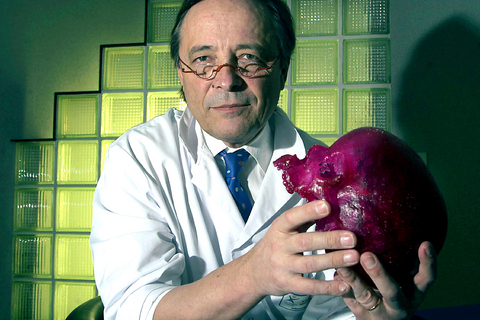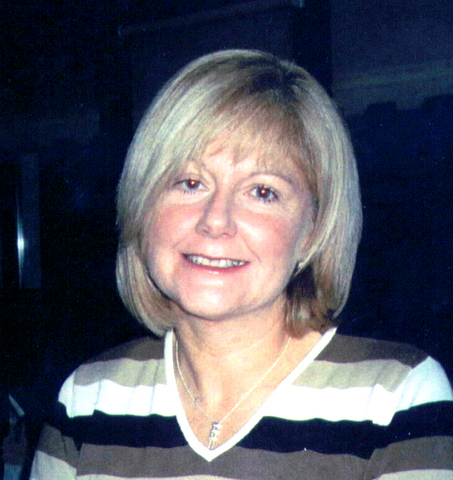As she waited for her pedicure at Just Calm Down, a day spa in New York, Vicki Murray, a 30-year-old homemaker, found herself engaged in a heated debate about extreme plastic surgery.
"Sure, if my face were injured or disfigured, I would think about a transplant," Murray said, adding matter-of-factly that under such radical conditions she would trade in her face for a comelier model, one with, say, the vulcanized features of Angelina Jolie.
Why not? Murray mused. "If celebrities put up their faces for auction after they died, people would be bidding on her features all the time."

Debbie Greengrass, a friend, pondered that assertion. "I have nothing against plastic surgery," said Greengrass, 30, a nurse practitioner at a New Jersey fertility clinic, "but accepting a skin transplant from an organ donor just to look like Angelina Jolie somehow doesn't set right with me."
The women's conversation, bizarre and of a sort customarily relegated to science fiction, was occasioned by the groundbreaking partial face transplant two and a half weeks ago in Amiens, France. A 38-year-old woman whose features had been gnawed away by her Labrador retriever received lips, a chin and a nose from a brain-dead donor. The procedure is considered by medical experts to be too experimental, and medically and ethically controversial, to have cosmetic applications.
Nonetheless the prospect of being able to one day swap one's features for a prettier, more idealized configuration seems to have sent the imaginations of people into overdrive, fueling discussion and over-the-top fantasies at the proverbial water cooler.

Among doctors and nonprofessionals alike, the medical and scientific advances that made possible the first face transplant raise issues both practical and moral, and touch on matters pertaining to class, wealth and the more profound question of human identity. The idea that a face might one day be as interchangeable as a watchband, a concept long popularized in futuristic novels and films, engenders reactions of mingled revulsion and awe.
"Replacing your features with those of a donor just to make yourself prettier -- that idea is abhorrent," said Sally Cook, an author of children's books who lives in New York. But Cook, 51, added she was deeply impressed to learn that the procedure was available and would favor such an operation for patients who were disfigured from birth or as the result of an injury.
Others, however, were more willing to entertain the possibility of a future in which a face transplant becomes a means by which one can trade in a shopworn mug as readily as exchanging an outmoded iPod for the newer, trimmer Nano model.

PHOTOS: AGENCIES
"We're standing on the edge of a new frontier," said Dr. Anthony Griffin, a plastic surgeon in Beverly Hills, who appears on Extreme Makeover, the ABC reality show. Griffin speculated that if a face transplant should become common practice, it would be easier to obtain abroad than in the US.
"We're too puritanical in America to ever allow face transplants for cosmetic reasons," he said, "but I can see someone like Michael Jackson flying to Paris for a nose transplant, although not in my lifetime."
To many people, living at a time when plastic surgery has lost much of its stigma -- total cosmetic medical treatments rose 24 percent over the past four years, says the American Society of Plastic Surgeons -- the idea of a new face requires no great leap of imagination, despite the medical hurdles. Sam Shahid, an advertising art director who once created a magazine cover in which the model's face was a pastiche of the features of other models, predicted that although the notion is bound to seem horrific at first, "once people get over the shock," it would become "acceptable, perhaps desirable."
A new face might one day be a covetable luxury item, suggested Scott Westerfeld, a science fiction writer, whose novels Uglies and Pretties project a future in which a compulsory operation at 16 makes everyone conform to an ideal standard of beauty.
In that future world, "it's not just how much cosmetic surgery you get, it's how often," Westerfeld said, adding, "There will come a day when having extreme cosmetic surgery will be like buying a US$1,000 Gucci bag, an indication that you are a member of the privileged class."
Well before the first partial face transplant became a reality, writers, filmmakers and other visionaries were depicting that future as a promising, though grotesque, inevitability.
As Hanif Kureishi has his hero observe in The Body, his novel last year about a 60-year-old writer whose brain is transferred into the fresh corpse of a young man, "It seems logical that technology and medical capability only need to catch up with the human imagination or will."
In October, Elle magazine published a cover depicting the distant future, one eerily anticipating the transplant in France. It featured Claudia Schiffer ("Still Sexy at 135!") with a cover line asking, "How He Feels About Your Face Transplant."
"We were being humorous," said Roberta Myers, the editor of Elle, acknowledging that thanks to movies and popular television dramas like FX's Nip/Tuck, which explores the outer limits of plastic surgery, and reality shows like The Swan, on Fox, which raises the possibility of an infinitely mutating identity through cosmetic surgery, people might not find the concept of a face transplant so far-fetched. (On a Nip/Tuck episode last week, the face of a brain-dead young woman was grafted onto a burn patient, whose immune system rejected the transplant.)
Westerfeld noted that such themes, once the province of science fiction, now parallel mainstream attitudes about the self and identity. There is increasing acceptance that "as human beings we get to choose who we are," he said. "And the line between what you get to choose and don't choose is moving all the time."
Plastic surgery first entered popular awareness in large part through movies, in a catalog of films dating back at least to the 1940s. In the noir classic Dark Passage, Humphrey Bogart plays an escaped prisoner who seeks a plastic surgeon to give him a new face and identity. In Eyes Without a Face, a 1959 French horror movie, a famous surgeon kidnaps young women to strip off their skin and graft it onto the face of his disfigured daughter. And in Seconds, a 1966 John Frankenheimer fantasy, a nondescript aging bank clerk is transformed via surgery into a youth with the features of Rock Hudson.
A more contemporary variation of that theme is encountered in Face/Off, in which a terrorist (Nicolas Cage) trades faces with the FBI agent (John Travolta) who is pursuing him.
Filmmakers have been persistently fascinated by plastic surgery because, as the art historian Juergen Mueller has written, "It is used to dramatize or reflect on the essence of identity." In his essay Plastic Surgery in Movies, published in Aesthe-tic Surgery (Taschen, 2005), Mueller, chairman of the art history department at Dresden University, argues that in films like Seconds or Face/Off, the face is both the "proof and the expression of personality."
"In this context, a look in the mirror brings with it the question of identity, of whether inside and outside still correspond," he writes.
In real life, some argue, a medical procedure that necessarily tampers with identity might take an unacceptable psychic toll. "The implications are shudder-worthy," said the writer Daphne Merkin. "Can you borrow someone else's features and still be you?"
Noting that Botox and plastic surgery have already eroded the idea of character by erasing laugh and frown lines, she asserted that such a face transplant might eliminate the concept of character. "Are we equipped to deal with this aesthetic fungibility?" she said.
In the case of the French transplant patient, Isabelle Dinoire, critics have raised questions about the psychological impact of having another person's features -- in this case, a donor who may have committed suicide, it was revealed this week.
Medical experts point out that a transplant recipient would never acquire exactly the features of another person, because the recipient's underlying bone structure would affect the way the skin appears.
Face transplants are difficult and controversial in large part because of the risk that the recipient's immune system will reject the borrowed tissue. The patients must take strong immune-suppressing drugs for the rest of their lives and these may cause cancer or be toxic to the heart, doctors say.
The day of routine practical transplants, even of a part of the face, is "very, very far off," said Dr. Peter Cordeiro, the chief of plastic and reconstructive surgery at Memorial Sloan-Kettering Cancer Center in New York.
And why bother with a transplant at all, some ask, when conventional surgery will do the job?
"Many people walking around, especially celebrities, already have had so many procedures that they no longer look like themselves," said Dr. Frederic Brandt, a dermatologist in New York and Miami who has a large celebrity following.
That notion is not lost on Janice Dickinson, a onetime supermodel and the author of Everything About Me Is Fake and I'm Perfect (Regan Books, 2004). Dickinson, who acknowledged in an interview having had a number of cosmetic procedures, including a face-lift, confided only half in jest that she would not mind trading in her features for a classier set. "I've been dying to look like Iman Bowie," she said referring to the model and cosmetics entrepreneur.
Nor is the concept of a transplant as a mark of privilege utterly alien to Suzanne Yalof Schwartz, the executive fashion director at Glamour magazine.
"If I had to have a face transplant, why not upgrade?" Schwartz asked. "I've lived long enough as a jalopy. I want to be a Jaguar."

Wooden houses wedged between concrete, crumbling brick facades with roofs gaping to the sky, and tiled art deco buildings down narrow alleyways: Taichung Central District’s (中區) aging architecture reveals both the allure and reality of the old downtown. From Indigenous settlement to capital under Qing Dynasty rule through to Japanese colonization, Taichung’s Central District holds a long and layered history. The bygone beauty of its streets once earned it the nickname “Little Kyoto.” Since the late eighties, however, the shifting of economic and government centers westward signaled a gradual decline in the area’s evolving fortunes. With the regeneration of the once

Even by the standards of Ukraine’s International Legion, which comprises volunteers from over 55 countries, Han has an unusual backstory. Born in Taichung, he grew up in Costa Rica — then one of Taiwan’s diplomatic allies — where a relative worked for the embassy. After attending an American international high school in San Jose, Costa Rica’s capital, Han — who prefers to use only his given name for OPSEC (operations security) reasons — moved to the US in his teens. He attended Penn State University before returning to Taiwan to work in the semiconductor industry in Kaohsiung, where he

On May 2, Chinese Nationalist Party (KMT) Chairman Eric Chu (朱立倫), at a meeting in support of Taipei city councilors at party headquarters, compared President William Lai (賴清德) to Hitler. Chu claimed that unlike any other democracy worldwide in history, no other leader was rooting out opposing parties like Lai and the Democratic Progressive Party (DPP). That his statements are wildly inaccurate was not the point. It was a rallying cry, not a history lesson. This was intentional to provoke the international diplomatic community into a response, which was promptly provided. Both the German and Israeli offices issued statements on Facebook

Perched on Thailand’s border with Myanmar, Arunothai is a dusty crossroads town, a nowheresville that could be the setting of some Southeast Asian spaghetti Western. Its main street is the final, dead-end section of the two-lane highway from Chiang Mai, Thailand’s second largest city 120kms south, and the heart of the kingdom’s mountainous north. At the town boundary, a Chinese-style arch capped with dragons also bears Thai script declaring fealty to Bangkok’s royal family: “Long live the King!” Further on, Chinese lanterns line the main street, and on the hillsides, courtyard homes sit among warrens of narrow, winding alleyways and